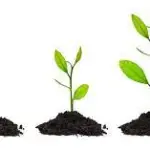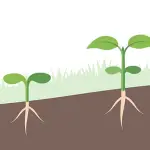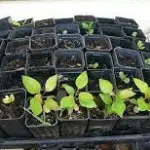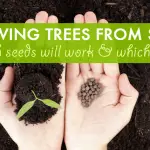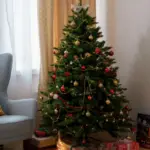
How to Plant Trees From Seed? Planting native trees are one of the best ways to reduce runoff and filter water in your area. Tree-planting efforts can also be a great project for your neighborhood, church, or other community organization.
Trees are some of the most beneficial plants you can grow, not only because they improve the quality of the air but also because they also help with water retention. When it comes to planting them, you have many different options.
There are several different types of trees that make great additions to any yard or garden. Whether you’re planting on your own property or with a community group, there are many ways to get those trees in place.
Since so many people have asked us about how to plant trees from seed, we decided to write this article with everything you need to know about doing exactly that!
Growing food-bearing trees from seed
While most food-bearing trees can be grown from seed, some are better suited for transplanting than others. Apples, pears, and peaches are excellent examples, but you’ll have to take special care to ensure that you’re getting pure varieties.
While the cost of buying young trees will be lower, you’ll have fewer chances of success.
Growing food-bearing trees from seed can be a wonderful way to improve your garden. Just be sure to plant the seeds as early as possible. Some varieties of food-bearing trees can even fruit in just three years, so it’s important to start early.
Preparing seeds for germination
Preparing seeds for germination before you plant them is vital for ensuring that they grow into healthy plants. Most seeds should be planted at a depth of no more than twice the thickness of the seed.
This depth is important because seeds are very small and do not have the energy to dig deep into dense soil. You should also plant seeds in a well-drained medium such as peat moss or vermiculite. Once sown, shake or tap the container so that the seeds are evenly spread out.
Preparing seeds for germination before you plant trees requires a few steps. First, you need to soak them in water. The water should be warm but not hot so that the seeds can absorb water.
The water should be changed every eight to twenty-four hours, depending on the species. Ensure that the water is filtered before you start soaking the seeds.
Stratification
Stratification is an important step in the process of planting trees from seed. This process ensures that your seeds are well-protected and reach optimal germination temperatures.
Some seeds require a long period of stratification before germinating, while others require a short period. The correct time for stratification depends on the type of seed and the climate in which it will be planted.
For example, tropical and temperate-climate trees may require warmer stratification periods before they are ready to be planted.
Stratification can be done in two ways: cold stratification is used to simulate winter, while warm stratification is used to simulate the end of summer.
Stratification can also be achieved through physical scarification, which involves scratching the seed coat and letting the seed absorb water.
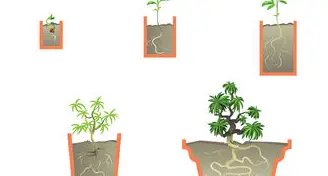
Scarification
Scarification is a process used to improve seed germination. It is not an arduous process. You can do it with a knife or nail clipper. Seeds with a hard seed coat, such as tomatoes, may require nicking to improve germination.
However, scarification isn’t necessary for all seeds.
If you don’t want to burn your seeds, you can use the thermal scarification method. To do this, you will need to soak the seeds overnight or for several hours. After scarification, you can plant the seeds.
Don’t store the scarified seeds for a long period of time, as they lose their viability.
Using a cocoon
Using a cocoon to plant trees is a great way to help preserve the environment. Cocoons are reusable, compostable containers that create a microclimate for seedlings.
This environment allows them to thrive even without regular water or rainfall. The cocoon also contains wicks that transport water to the seedling’s roots. This drip system helps the trees grow roots that are both deep and wide.
This unique device was created by the Land Life Company, which began prototyping Cocoons in 2013. At the time, these wicks were simple paper pulp buckets that encircled the seedling.
The researchers then improved the design, eventually coming up with a more recognizable three-dimensional cocoon.
Using a Drone
Using a drone to plant trees from seed can improve the efficiency of forest restoration projects. The drone can survey the area in high definition and drop seed pods with high precision.
It can also use a pneumatic firing device to propel seedlings deep into the soil. Once planted, drones can follow their progress and provide nutrients for the growing plant.
AirSeed has already planted more than 50,000 trees and aims to reach its goal of 100 million by 2024. According to the United Nations Environment Programme, the world loses about 70,000 square kilometers of forest per year, roughly the size of Portugal.
The organization wants to halve this deforestation rate and end net deforestation by 2030. The drone-planting technology has the potential to help the environment while helping local communities improve their livelihoods.
Conclusion
As with any planting, it is important to understand that you can’t just plant seeds. You need to provide the right environment for them to grow and thrive. Seeds need to be soaked, they need oxygen-rich soil (or very porous soil), they need maximum sunlight exposure (at least 6 hours a day during peak growing season), and a temperature of 60°-75°F.
The right environment and proper care will help your seedlings thrive and grow into full-grown trees. When planting trees from seed, you can either choose to buy the seeds or get them from a nursery.
Natives are the most expensive to grow but are also the most dependable. Planting trees from seeds can be a fun and rewarding experience, and the only thing you need is access to an area where soil and water are available.
Seeds can be found at home and garden stores, as well as online retailers. They are often sold in bulk, such as 5 or 10-pound bags so that you can plant as many trees as possible in your yard.
To ensure good germination, choose seeds that are at least 2 years old. If you don’t know how old the seeds are, then you should ask the store you purchased them from.
Thanks for stopping by serconline.
Useful links:
https://serconline.org/knowledge-base/
https://serconline.org/product-reviews/
https://serconline.org/about-us/
https://serconline.org/contact-us/

